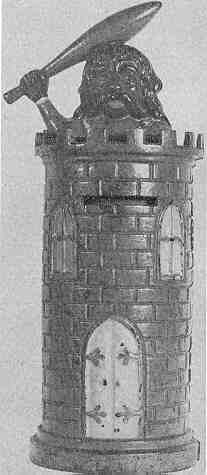Giant in Tower Bank
by F.H. Griffith - HOBBIES Magazine - March, 1961
 Mechanical banks as a collector’s item have received
increasing recognition, interest, and activity since the early 1930’s. There are
known cases where the animated banks were collected prior to this time, in the
1920’s, but the real competitive situation among collectors of these toy mechanical
savings devices actually began in the period of the 1930’s. These were the times of
the so-called pioneer collectors and such names as Chrysler, Corby, Emerine, Jacobs,
Jones, Marshall, Meyers, Ferguson, and several others are well remembered by the writer.
The active specialist mechanical bank dealer of this early period was the never to be
forgotten personality, Norman E. Sherwood, who lived in Asbury Park, N.J., and
subsequently moved to Spring Lake, N.J. In each location he operated his bank business
from his home and displayed the items for sale, as well as selling by mail and making
personal deliveries to some of the collectors.
Mechanical banks as a collector’s item have received
increasing recognition, interest, and activity since the early 1930’s. There are
known cases where the animated banks were collected prior to this time, in the
1920’s, but the real competitive situation among collectors of these toy mechanical
savings devices actually began in the period of the 1930’s. These were the times of
the so-called pioneer collectors and such names as Chrysler, Corby, Emerine, Jacobs,
Jones, Marshall, Meyers, Ferguson, and several others are well remembered by the writer.
The active specialist mechanical bank dealer of this early period was the never to be
forgotten personality, Norman E. Sherwood, who lived in Asbury Park, N.J., and
subsequently moved to Spring Lake, N.J. In each location he operated his bank business
from his home and displayed the items for sale, as well as selling by mail and making
personal deliveries to some of the collectors.
The early collectors and dealers in mechanical banks deserve due recognition for their efforts in establishing a hobby that has continued to increase in popularity to the present time and shows every evidence of continuing to do so in the future. Many different specimens of mechanical banks were brought to light in this earlier period of collecting. It was natural, of course, that in the pioneer period previously unknown examples of mechanical banks would turn up with some frequency, but what has been of great interest to the writer is the fact that this same situation has continued to occur up to the present time. Perhaps the frequency of a new discovery does not occur as often as in the past but it certainly has been a continuing factor of real interest and stimulation to the collectors.
The factors surrounding new discoveries in mechanical banks apply not only to those made in the United States, but also to those of foreign manufacture. As a matter of fact it is in the more recent times that foreign banks have really come into their own and factual background material established so that more and more is known about them. As we reach No. 93 in the numerical classification we have selected as our choice an English bank that was unknown until a few years ago. This bank is the Giant In Tower and it is a very interesting, attractive item. The writer, through old catalog material, had evidence that the bank had been manufactured but it was only recently that one was finally discovered and then another turned up, and undoubtedly there will be more found in the future.
The specimen shown is in the fine collection of Leon J. Perelman and he obtained it from a Pennsylvania antique dealer in the early part of 1960. The bank in turn was obtained by the dealer through a contact in England. It is in practically mint condition and completely original.
The bank was registered August 13, 1892 by John Harper & Company Ltd. and manufactured by this same concern. One of their old catalogs which is in the writer’s possession pictures the bank and advertises it as the Giant. To avoid confusion with the Giant Bank (HOBBIES, July 1952) made in our country the writer has named the English bank under discussion Giant In Tower. This name is simple, completely descriptive, and eliminates any possibility of confusion.
Mr. Perelman is quite fortunate in that his pictured specimen of the bank is in extra fine paint condition. The tower is an overall brick red and the door and windows are yellow. The body of the Giant is brown and his face and hand are black. His tongue is red, as is the club held in his hand. As to the action of the bank, it is quite simple but effective. A coin is inserted in the slot located between the top arches of the two front windows. As the coin is pushed into this slot the Giant tilts forward as though threatening the depositor. The figure returns to its normal upright position as the coin drops inside the tower. The operation of the bank is the same principle as Mama Katzenjammer (HOBBIES, December 1958).
In closing it bears mention that the Harper catalog picturing the Giant In Tower states that it came with two different finishes, one in various colors, the same as Mr. Perelman’s specimen, and another in what Harper called "Indian Black with the head painted only." The one in various colors originally sold for a slightly higher price per dozen than the Indian Black finish.
